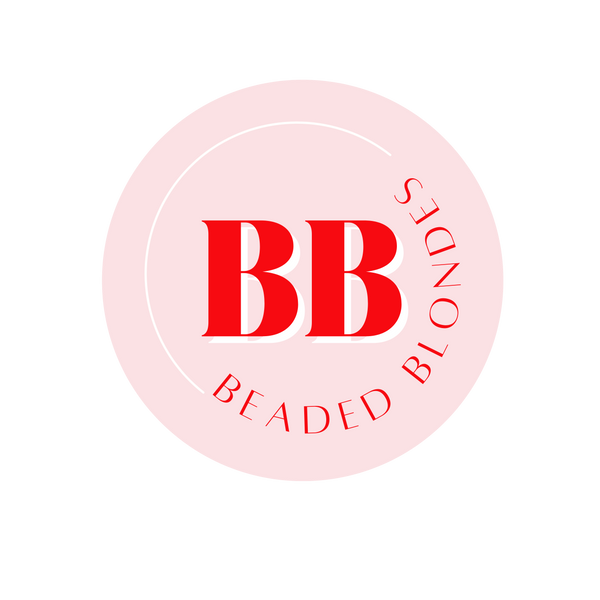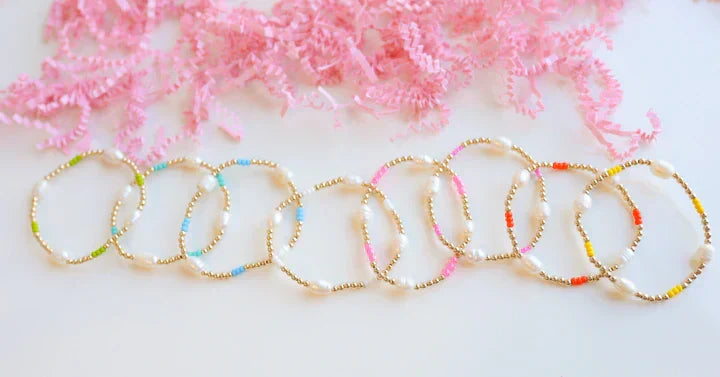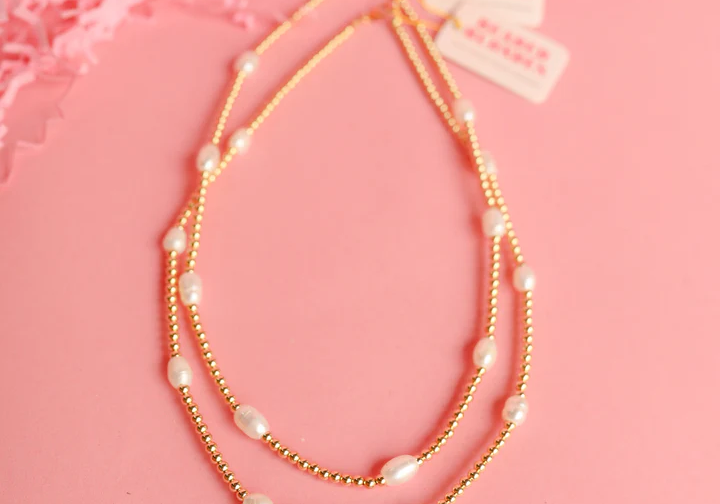Shopping for gold jewelry can be a bit overwhelming, especially when it comes to deciding between 14K and 18K gold. From durability to color and even how it feels on your skin, each has its own benefits and drawbacks.
Knowing these differences can help you make an informed choice, leaving you with a piece that not only fits your budget but also reflects your style. This blog will break down everything you need to know about 14K and 18K gold so you can shop with confidence.
Difference Between 14K and 18K Gold Jewelry
Gold is rarely used in its purest form for jewelry since it’s too soft on its own, meaning it can bend or scratch easily. Instead, jewelers blend pure gold with other metals to strengthen it, creating “karat” gold. The most common choices are 14K and 18K, each offering a balance between appearance, durability, and cost.
By understanding what these are, you can find the ideal gold jewelry that suits your lifestyle and preferences, from delicate pieces like a beaded gold necklace to everyday wear like a 14k gold bead bracelet.
Percentage of Pure Gold
The main difference between 14K and 18K gold is how much pure gold they contain. Gold purity is measured in “karats” (K). Different karats offer varying gold percentages, durability, and color depth, giving you several options.
-
10K gold: Contains 41.7% pure gold and 58.3% other metals. This karat has the lowest gold content and is legally sold as “gold” in many countries. It has a paler color than higher karats, and while it’s highly durable, some may find it less desirable due to its lower gold percentage.
-
14K gold: Consists of about 58.3% pure gold, with the remaining 41.7% made up of other metals, such as silver, nickel, or copper. This blend provides excellent durability while maintaining an attractive gold color. It's a popular choice for wedding rings, engagement rings, and everyday wear items.
-
18K gold: Contains 75% pure gold and 25% alloyed metals, resulting in a slightly richer color than 14K. Its higher gold percentage gives it a more luxurious look, though it’s softer and more prone to scratching. This balance makes 18K gold ideal for fine jewelry or pieces meant for occasional wear.
-
22K gold: Composed of 91.7% pure gold and only 8.3% alloyed metals. This karat has a deep, vibrant yellow color but is quite soft, so it’s mainly used in simple jewelry designs without stones. Due to its softness, 22K gold isn’t recommended for items that see heavy wear, so it’s rarely used for jewelry.
While 14K gold is more practical for items you plan to wear daily, the purer content of 18K gold offers a richer hue for those seeking a luxurious look. The choice often depends on what you focus on in terms of color, durability, and value.
Durability
Durability is crucial in deciding between 14K and 18K gold, especially if you want durable jewelry. Generally, the more alloy metals a piece contains, the stronger it becomes.
-
14K Gold: Known for its toughness, 14K gold is an excellent choice for those with active lifestyles or who wear their jewelry daily. Its extra alloy content makes it more resistant to scratches and dents and is ideal for wedding rings and custom bead bracelets.
-
18K Gold: While 18K gold has a beautiful, rich color, it’s softer due to its higher gold content. It’s more prone to scratches and might not stand up as well to constant wear, especially on rings or bracelets that get bumped around.
For most wearable jewelry, 14K gold provides an excellent mix of durability and elegance. In comparison, 18K is better suited for occasional wear or for those who prioritize a higher gold content over toughness.
Lifestyle
Your daily activities and lifestyle can also influence the type of gold that’s best for you.
-
14K Gold: If you have a hands-on job, enjoy sports, or want jewelry that withstands daily wear and tear, 14K gold is likely the better choice. Its sturdy composition makes it less prone to scratches, which is helpful for people who don’t want to worry about their jewelry getting damaged.
-
18K Gold: For those who wear jewelry primarily for special events, 18K gold can be an ideal choice. Its higher gold percentage provides a luxurious look, making it perfect for unique pieces that stand out.
In short, think about how often you plan to wear each piece. Those with more active lifestyles typically find 14K gold suits them better, while those looking for something special to wear occasionally may appreciate the higher gold content of 18K.
Value
Gold prices fluctuate based on purity, design, and market demand. The higher the gold content, the more you might pay.
-
14K Gold: Due to its lower gold content, 14K gold is more affordable, making it popular for engagement rings and wedding bands. You get the beauty of gold without as high of a price, which appeals to budget-conscious shoppers.
-
18K Gold: With a higher gold content, 18K jewelry is generally pricier than 14K. This cost difference can be considerable for pieces that use a significant amount of gold, such as large necklaces or bracelets. However, for those who seek a richer gold hue and are willing to invest in it, 18K gold offers that extra touch of luxury.
If you’re looking for fine jewelry without breaking the bank, 14K gold is a practical choice. But if you want something with a higher percentage of gold and a more vibrant color, 18K might be worth the investment.
Advantages and Disadvantages of 18K Gold
18K gold is often associated with luxury, offering vibrant color and fewer alloyed metals, which may make it better for those with skin sensitivities. This high-purity gold is also hypoallergenic and has a warmer, more intense tone than other karats, which appeals to many for special jewelry pieces. It’s frequently chosen for costume jewelry and items that don’t see heavy wear. Some of the most popular advantages of 18k gold include:
-
A higher percentage of pure gold gives it a richer, more luxurious color.
-
Being less likely to cause skin irritation due to fewer alloy metals.
-
A vibrant appearance is ideal for special occasions or statement pieces.
However, 18K gold isn’t the best option for everyone. This type of metal has some potential downsides, such as:
-
Being more prone to scratches because of its softness, especially in pieces that see a lot of use.
-
A higher price due to the increased gold content.
-
Not as durable as 14K gold, which can make it less suitable for daily wear.
For those who want something with a pure, high-end feel, 18K gold can be an excellent option. However, it’s worth keeping in mind the extra care it may require.
Advantages and Disadvantages of 14K Gold
14K gold provides the best of both worlds with a great mix of gold purity and durability. Its sturdier composition makes it ideal for pieces worn daily. This karat is often chosen for wedding rings and other long-term jewelry. The pros of 14k gold are:
-
It's extremely durable, making it ideal for jewelry worn every day, like custom bead bracelets.
-
It's more affordable and appealing to a wide range of budgets.
-
Its blend of metals makes it less likely to show wear and tear over time.
On the downside, some people may be slightly sensitive to non-gold metals, like nickel, in 14K gold, which could cause skin irritation. However, this varies from person to person. Some cons of 14k gold are:
-
It may cause skin sensitivities in some individuals, mainly if it contains nickel or other alloys.
-
It has a slightly lighter color than 18K gold, which may not be as rich for those seeking a deeper hue.
14K gold is a smart option for those who want something practical, beautiful, and durable, especially for pieces that may take a few knocks throughout the day.
Which is better? 14K or 18K Gold
Choosing between 14K and 18K gold depends on what you value most in your jewelry. For those who focus on cost and durability, 14K gold offers an attractive option that’s affordable and tough enough for everyday wear. If a vibrant color and purer gold content are more appealing, 18K gold provides a beautiful choice, albeit at a higher price and with the need for more careful handling.
Consider what you want in your jewelry. If you have an active lifestyle and want a piece that will withstand daily wear, 14K gold could be ideal. For something that shines with a rich tone and feels special, 18K gold may be just right.
What Type of Gold is Best For You?
The type of gold you choose affects the final look of your jewelry and how well it complements your skin tone.
Yellow Gold
Yellow gold, made by mixing pure gold with copper and silver, maintains the classic gold color. It’s often the choice for those who love traditional styles and suit warm skin tones beautifully. Both 14K and 18K yellow gold have their merits, though 18K will have a deeper, more vibrant tone.
Rose Gold
For a romantic touch, rose gold is a wonderful option. It’s made by blending pure gold with copper, giving it that distinctive pinkish hue. Because of the copper, 14K rose gold is more durable than 18K, making it ideal for daily wear.
White Gold
White gold is created by alloying gold with metals like silver or palladium, then coating it in rhodium for a shiny finish. 14K white gold tends to be stronger, while 18K is valued for its higher gold content. Both are popular choices for a sleek, modern look.
Regardless of color, think about how each finish aligns with your style and how often you plan to wear the piece.
What's Better for Your Skin Tone and Sensitivity?
If you have sensitive skin, 18K gold might be the better choice due to its higher gold content and lower likelihood of causing irritation. This is crucial if you’re prone to allergies to metals like nickel, often found in 14k gold. Some opt for rhodium plating to reduce skin contact with alloyed metals for added safety.
When selecting gold, consider your skin’s tolerance to different alloys, especially if you plan to wear the jewelry daily. For those with severe allergies, 18K gold offers a purer option with a reduced chance of causing skin irritation.
Your Golden Choice Awaits at Beaded Blondes
You might be drawn to the durability of 14K gold or the luxurious look of 18K gold — either way, Beaded Blondes has a beautiful selection of beaded jewelry that reflects style and quality. From beaded gold necklaces to custom pieces perfect for special occasions, there’s something for everyone. Visit us to browse our collection or buy beaded bracelets and find the ideal blend of beauty and resilience.
We look forward to helping you find a piece you’ll treasure!





